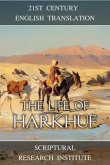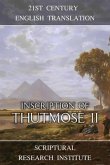The life of Weni, also called Uni, is one of the best-documented lives from the era of the Old Kingdom era of Egyptian history. Weni experienced significant upward mobility during the reigns of kings Teti, Userkare, Pepi I, and Merenre I, and as a result had a second tomb prepared for himself later in life, resulting in two of his tombs surviving to the present. His tombs were not extravagant like the king's pyramids of the era, and seem to have generally been ignored until rediscovered in the 1800s. His earlier, smaller tomb included the shorter Inscription of Weni, sometimes called the Tomb Inscription of Weni, while his later, larger tomb included the longer Autobiography of Weni, also sometimes called the Inscription of Weni, or Tomb Inscription of Weni.
The second, longer Autobiography of Weni is the longest surviving text from the Old Kingdom that is non-religious and provides a glimpse into the lives of the royal court, as well as the extent of the Old Kingdom's power within Nubia and Canaan. The older inscription is believed to date to late in the reign of King Pepi I, as Weni doesn't mention anything after the campaigns in Canaan. The larger inscription includes Weni's expeditions into Nubia for King Merenre I, who reigned after Pepi I, and provides a brief Egyptian description of Nubia during the Old Kingdom era.
Weni's life spanned most of the 6th Dynasty of the Old Kingdom, which would have been at the peak of the Old Kingdom's international reach, but after the major pyramid-building feats of the 5th Dynasty were completed. Egypt had already built the tallest building in the world decades before Weni was born, which would continue to be the tallest building in the world for thousands of years. The 6th Dynasty continued to build pyramids, however, none came close to the engineering accomplishments of the 5th Dynasty. One pyramid, which King Merenre I built, is mentioned prominently in the later section of the autobiography. It is believed to have been the Pyramid of Merenre at Saqqara, although it might have been a different pyramid for one of his wives.
The second, longer Autobiography of Weni is the longest surviving text from the Old Kingdom that is non-religious and provides a glimpse into the lives of the royal court, as well as the extent of the Old Kingdom's power within Nubia and Canaan. The older inscription is believed to date to late in the reign of King Pepi I, as Weni doesn't mention anything after the campaigns in Canaan. The larger inscription includes Weni's expeditions into Nubia for King Merenre I, who reigned after Pepi I, and provides a brief Egyptian description of Nubia during the Old Kingdom era.
Weni's life spanned most of the 6th Dynasty of the Old Kingdom, which would have been at the peak of the Old Kingdom's international reach, but after the major pyramid-building feats of the 5th Dynasty were completed. Egypt had already built the tallest building in the world decades before Weni was born, which would continue to be the tallest building in the world for thousands of years. The 6th Dynasty continued to build pyramids, however, none came close to the engineering accomplishments of the 5th Dynasty. One pyramid, which King Merenre I built, is mentioned prominently in the later section of the autobiography. It is believed to have been the Pyramid of Merenre at Saqqara, although it might have been a different pyramid for one of his wives.
Dieser Download kann aus rechtlichen Gründen nur mit Rechnungsadresse in A, D ausgeliefert werden.









